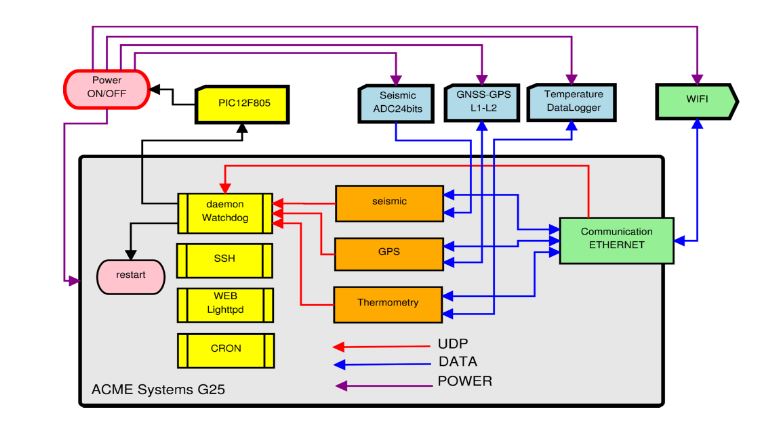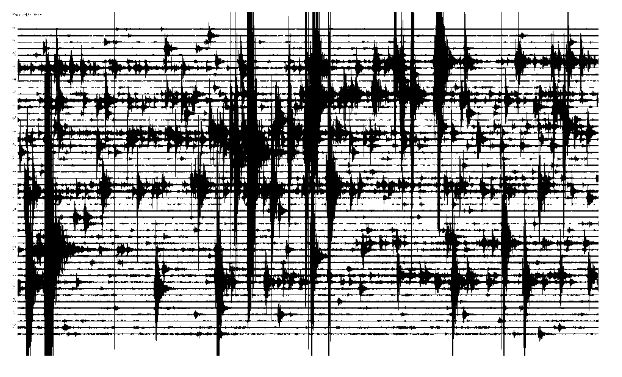ABSTRACT
This paper describes the development of a multi-parameter system for monitoring volcanic activity. The system permits the remote access and the connection of several modules in a network. An embedded ARMTM processor has been used, allowing a great flexibility in hardware configuration. The use of a complete Linux solution (DebianTM) as Operating System perm its a quick, easy application development to control sensors and communications.
This provides all the capabilities required and great stability with relatively low energy consumption. The cost of the components and applications development is low since they are widely used in different fields. Sensors and commercial modules have been combined with other self-developed modules.
The Modular Volcano Monitoring System (MVMS) described has been deployed on the active Deception Island (Antarctica) volcano, within the Spanish Antarctic Program, and has proved successful for monitoring the volcano, with proven reliability and efficient operation under extreme conditions. In another context, i.e., the recent volcanic activity on El Hierro Island (Canary Islands) in 2011, this technology has been used for the seismic equipment and GPS systems deployed, thus showing its efficiency in the monitoring of a volcanic crisis.
MODULAR VOLCANO MONITORING SYSTEM (MVMS)

Figure 1. Components of the MVMS (block diagram of the modules)
The DRC receives and processes the data and, in case of unrest or surveillance of an eruption, the Scientific Team (ST) analyzes in quasi real time the data and provides forecasts. Each module of the RMN (Remote Module, RM) includes an embedded ARMTM system and the communication system (see Figure 1).

Figure 4. Watchdogs management
A microcontroller (Microchip PIC12F508) is used as an external hardware watchdog system to reboot the system when the ARM-module hangs. In Figure 4, the hardware-software structure for the management of the watchdog is shown. All applications periodically send a UDP message to the watchdog daemon of the G25 ARMTM system.
MVMS APPLICATIONS: DECEPTION ISLAND (ANTARCTICA) AND EL HIERRO ISLAND (CANARY ISLANDS)

Figure 9. Seismic record of 2013/03/29, during the main magma injection process
The communications system and the ARMTM module operate in continuous mode to allow near real-time monitoring. In the moments of greatest activity Internet and mobile telephony were not available so the access to the stations was only possible with direct connection (wire or Wi-FiTM). Data from other stations required manual access (volunteers, citizen cooperation). Figure 9 shows a 24 h seismic record. This network allowed the scientific monitoring of the volcanic activity and the evolution forecast establishment.
CONCLUSIONS
This paper describes the development of an autonomous Monitoring Volcanic Multi-parameter System (MVMS) with remote access possibility and connection of several modules in a network. The MVMS is very easy to deploy for both research and/or monitoring network that uses the latest technologies of embedded systems, and to incorporate any type of sensor and/or communication system. Another advantage of MVMS is the possibility of a rapid development of the software necessary for managing the sensors and instruments available.
The price of both hardware and software is very low. The MVMS consists of a network (or a network of networks) of Remote Modules (RMN) that receive the data via cable or through wireless links from sensors, store them locally on a large capacity support (Compact Flash (CF), Secure Digital (SDTM), USB memory, etc.), make a first processing and send warnings. Data can be transmitted in near real time or on demand to a Data Reception Center (DRC). The local storage allows retrieving data when the transmission fails and uses only short transmission periods rather than continuous transmission.
An embedded ARMTM system (highly reliable low-cost solution) with enough storage and processing capacity has been chosen. An Operating System (OS) for specific embedded ARM TM processors has been used: EmDebian TM Grip Linux 7.1―Wheezy‖ embedded device Linux Kernel version 3.11. This OS offers great flexibility to develop applications related to different sensors (seismic, thermometry, GPS, etc.) including data processing and generation of warnings related to the change of activity in the volcanic system.
It also allows the implementation of different communication protocols (satellite, telephony, Wi-Fi TM, serial, etc.). ARM-modules can work as specific sensors networks (e.g.,infrasounds, seismic array, etc.). Some ARM-modules can configure a network that sends data to a great capacity central module for data processing and transmission.
Source: University of Cadiz
Authors: Luis Miguel Peci | Manuel Berrocoso | Alberto Fernandez-Ros | Alicia Garcia | Jose Manuel Marrero | Ramon Ortiz
>> More Wireless Embedded Projects for Final Year Students